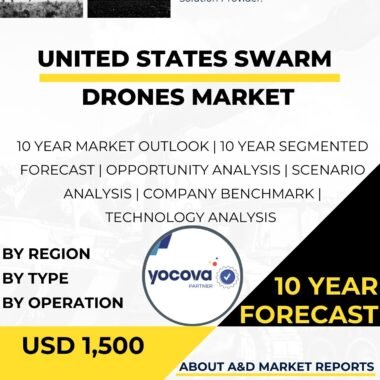Description
China’s rise in the global swarm drones market reflects its strategic ambitions to bolster its military capabilities, enhance national security, and position itself as a leading player in the evolving landscape of unmanned aerial systems (UAS). Swarm drones, which involve the coordinated deployment of large numbers of small unmanned aerial vehicles (UAVs), have gained significant attention in recent years due to their potential in a wide range of military applications.
China has made substantial investments in swarm drone technology, with a focus on developing advanced UAVs equipped with artificial intelligence (AI), autonomous capabilities, and collaborative behaviors. These swarm drones can perform tasks such as reconnaissance, surveillance, electronic warfare, and target engagement with remarkable efficiency and coordination.
One of the key advantages of swarm drones is their ability to overwhelm adversary defenses and disrupt enemy operations. China’s advancements in swarm drone technology enable it to deploy large swarms of drones that can saturate enemy air defenses and confuse radar systems. This capacity enhances China’s ability to conduct electronic warfare, collect intelligence, and target adversary assets effectively.
Furthermore, China’s swarm drones have been designed for both offensive and defensive purposes. They can be equipped with a variety of payloads, including electronic warfare systems, small munitions, and sensors. This versatility allows China to adapt its swarm drones to various military scenarios, making them a formidable force on the modern battlefield.
China’s proficiency in swarm drones extends to the development of sophisticated swarm management and communication systems. These systems enable operators to control and coordinate swarms of drones, ensuring they operate in unison to achieve mission objectives. The integration of AI technology enhances the decision-making capabilities of swarm drones, allowing for real-time adjustments and adaptive behaviors in dynamic environments.
Internationally, China’s strides in the swarm drones market have significant implications for global security dynamics. Its growing capacity to deploy swarms of drones, particularly in contested regions such as the South China Sea, has raised concerns among neighboring countries and the broader international community. China’s swarm drone capabilities enable it to project power, assert territorial claims, and exert influence in strategic areas.
In conclusion, China’s investments and advancements in the swarm drones market signify its determination to strengthen its military capabilities and protect its national interests. Swarm drones offer a transformative approach to modern warfare, and China’s position as a prominent player in this field enhances its strategic influence and capabilities. As China continues to expand its military presence and assert its influence in regional and global contexts, its swarm drone capabilities will likely shape the dynamics of modern warfare and international security in the coming years.




